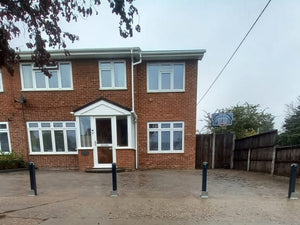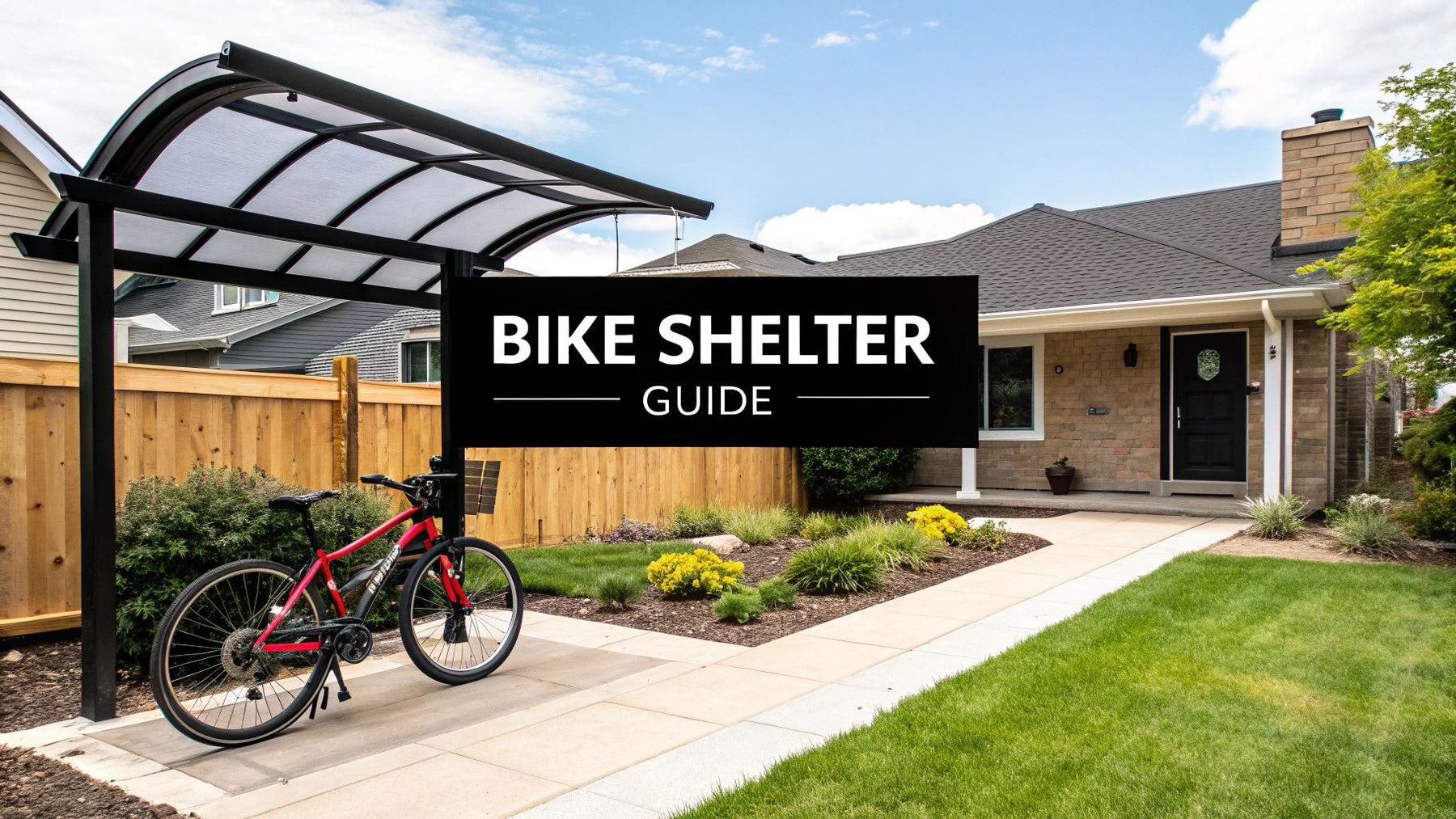
Choosing the Best Home Bicycle Shelter for Your UK Home
The freedom of a great bike ride can quickly vanish when you're left worrying where to store your cycle. This is where a dedicated home bicycle shelter becomes essential. As a family-owned British business, we've been helping homeowners protect what matters since 1972, and we know that a proper shelter is the best way to secure your pride and joy from both opportunistic thieves and the unpredictable British weather.
A purpose-built shelter isn’t just a luxury; it’s a crucial part of your home's vehicle security.
Why Secure Bike Storage is No Longer Optional
As a family-owned British business that’s been all about security since 1972, we’ve seen how criminal methods have changed over the years. Just as protecting cars on the driveway became a necessity, the same is now true for bikes.
Leaving an expensive bike in a flimsy wooden shed or just chucking a tarpaulin over it is practically an open invitation for thieves, who can get through basic locks in seconds. A purpose-built, secure home bicycle shelter gives you targeted, robust protection that you just don't get from casual storage.
The need for better security is growing, simply because more of us are cycling. Government data shows a steady rise in cycling in England, with a whopping 926 million cycling stages recorded in 2022. That’s a huge jump over the last decade. More bikes on the road means more bikes needing a safe place to be stored. If you're interested, you can read the full government report on cycling statistics to see the trends for yourself.
The Twin Threats to Your Bicycle
A quality shelter is designed to tackle the two biggest risks every UK cyclist has to deal with. It gives you peace of mind that a simple cover just can't offer.
- Opportunistic and Planned Theft: Today's bikes, especially e-bikes, are high-value items that thieves actively look for. A proper shelter is a serious physical deterrent, with features like integrated locks, reinforced panels, and the option to be bolted down to a solid base.
- The British Weather: Let’s face it, our weather isn’t kind. Rain, damp, and UV damage can all take their toll on your bike's components, leading to rust and expensive repairs down the line. A fully enclosed, weatherproof shelter keeps your bike clean, dry, and ready for your next ride, protecting its condition and value.
This infographic neatly sums up why a dedicated shelter is a must-have for protecting your bike from both thieves and the elements.
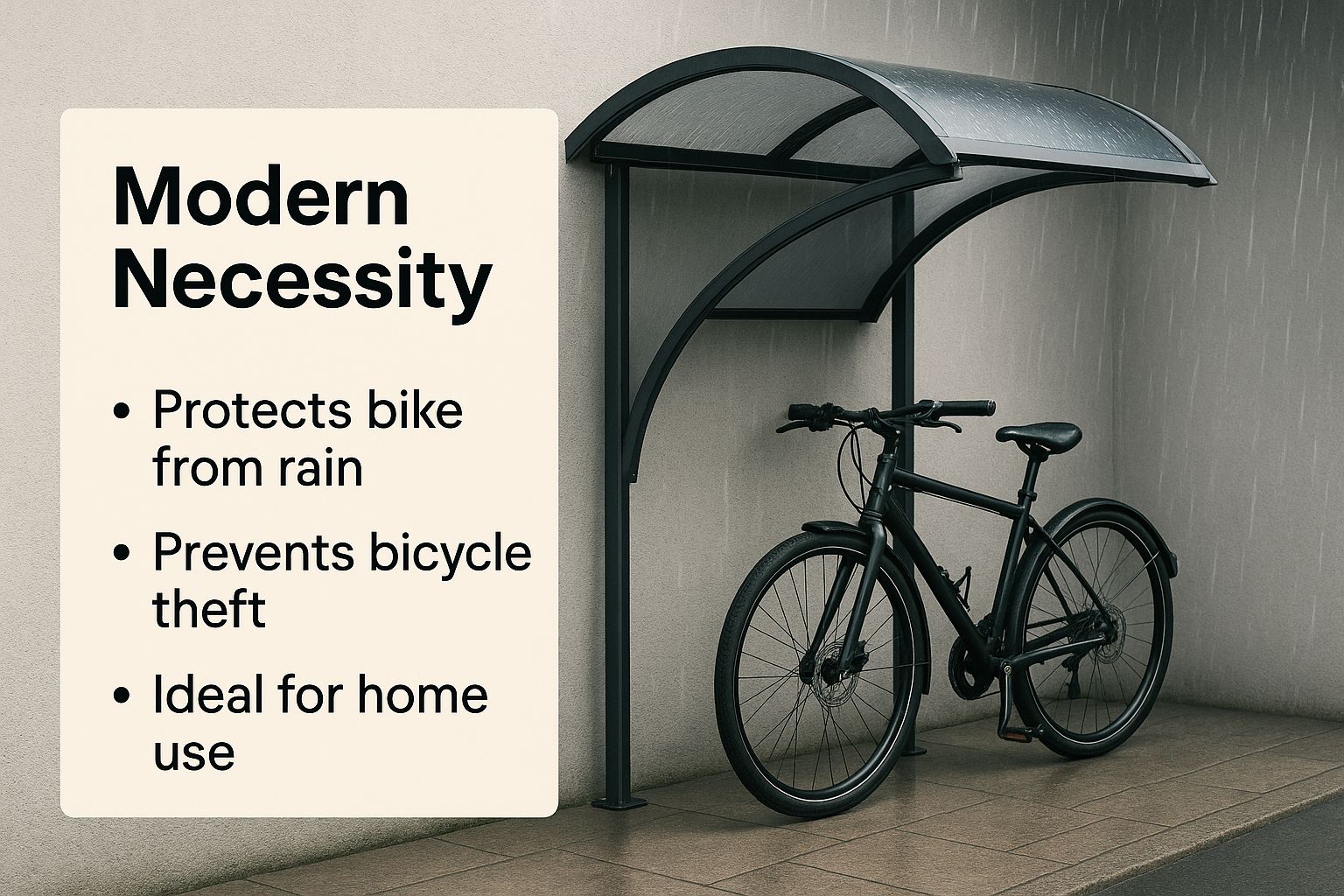
As the image shows, a shelter is much more than just a box; it’s a complete defence system for your valuable bike. Investing in one is a smart, proactive step to keep your property safe.
Finding Your Perfect Fit Among Shelter Types
Choosing the right home bicycle shelter can feel a bit like a puzzle, but it's much simpler when you know what you're looking for. Think of it like picking the right tool for a job – you wouldn't use a sledgehammer to hang a picture. We’ll walk through the main options out there for UK homeowners, making it easy to find the perfect match for your space and your bikes.
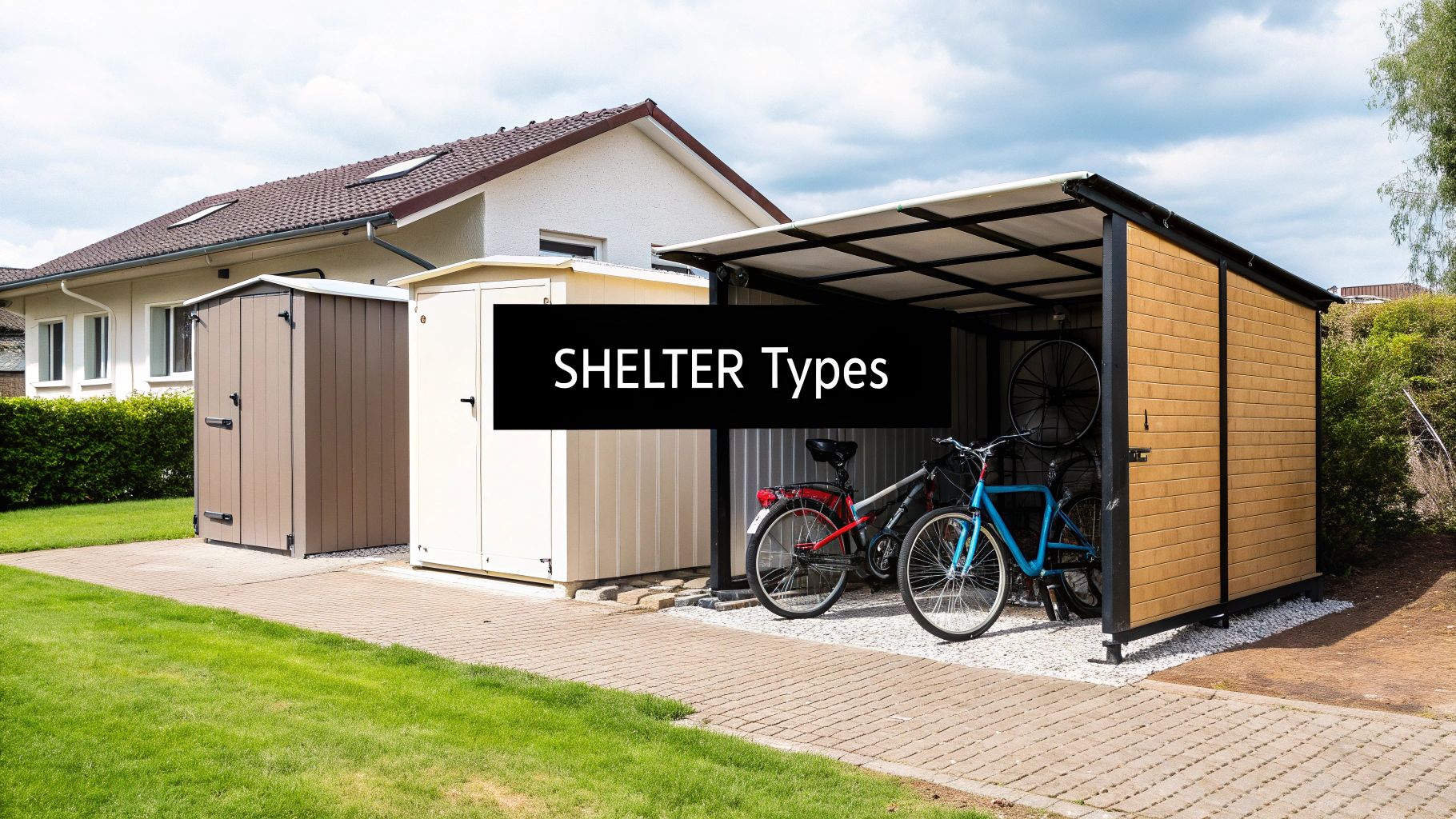
We'll explore everything from tiny single-bike lockers to larger units designed for the whole family's collection of cycles. The goal here is to give you a clear map of the landscape so you can confidently pick a shelter that gives you the best possible security for your pride and joy.
Compact Bike Boxes and Lockers
Bike boxes or lockers are the personal safes of the cycle storage world. These are normally compact, self-contained units built to securely house just one or two bicycles.
Their small footprint makes them a brilliant solution for homes with limited outdoor space, like terraced houses with small front gardens, patios, or even balconies. They offer a really high level of security in a discreet package, keeping your bike completely out of sight and shielded from the Great British weather.
- Best For: Single cyclists, couples, or anyone with a high-value bike and not much space to spare.
- Typical Capacity: 1-2 bikes.
- Key Advantage: An excellent security-to-size ratio, perfect for tight spots.
These units are all about maximum protection in a minimal area, which is why they’re so popular in busy urban environments like London or Birmingham where every square foot counts.
Horizontal and Vertical Bike Sheds
For those with a bit more room to play with, bike sheds strike a fantastic balance between capacity and convenience. Unlike a standard garden shed, these are purpose-built for storing bikes, meaning they come with better security features and space-saving designs from the get-go.
Horizontal sheds are low-profile units that store bikes on their wheels. They often feature large, easy-access doors or lift-up lids, making it dead simple to roll bikes in and out. They are ideal for back gardens or side returns where you might have height restrictions.
Vertical sheds, on the other hand, store bikes upright on their back wheel. This clever design drastically reduces the ground footprint, making them perfect for narrow spaces like the side of a house. They are a brilliant way to maximise your storage without sacrificing your garden. If you want to dive deeper into creative solutions, you might be interested in our guide covering more outdoor bike storage ideas.
Larger Cycle Hangars
When you need to store multiple bikes for the whole family – including bulky e-bikes or the kids' bikes – a cycle hangar is the ultimate solution. These are essentially mini garages for your bicycles, offering enough space to comfortably store three, four, or even more bikes.
These bigger units provide plenty of room not just for the bikes themselves but also for helmets, pumps, and other gear. They represent the highest level of home cycle security, often featuring multi-point locking systems and incredibly tough, British-made steel construction. As you look into different shelters, it can be useful to consider the broader range of different bike storage solutions available, especially for electric models.
As a family business focused on security since 1972, we understand that protecting your family's property is everything. A cycle hangar provides that comprehensive peace of mind, securing thousands of pounds worth of equipment in one robust, weatherproof unit.
Home Bicycle Shelter Comparison
To help you get a quick-glance comparison of the most common types of home bicycle shelters, we've put together this simple table. It should help you decide which style best fits your space, security needs, and the number of bikes you own.
| Shelter Type | Best For | Typical Capacity | Security Level | Space Footprint |
|---|---|---|---|---|
| Bike Box/Locker | High-value bikes in tight spaces | 1-2 Bikes | Very High | Small |
| Horizontal Shed | Easy access in garden settings | 2-3 Bikes | High | Medium |
| Vertical Shed | Maximising narrow spaces | 2-4 Bikes | High | Small |
| Cycle Hangar | Families and e-bike owners | 3+ Bikes | Very High | Large |
By understanding these core types, you can start to narrow down your options and focus on the solution that really meets your specific needs for space, capacity, and driveway protection.
Decoding the Features of a Truly Secure Bike Shelter
Knowing the different types of shelters is a great start, but what really separates a flimsy box from a proper fortress? When you're picking out a home bicycle shelter, getting to grips with the specific features is your best defence against thieves and the notoriously damp British weather. Think of this as your buyer's checklist for spotting real quality and security.
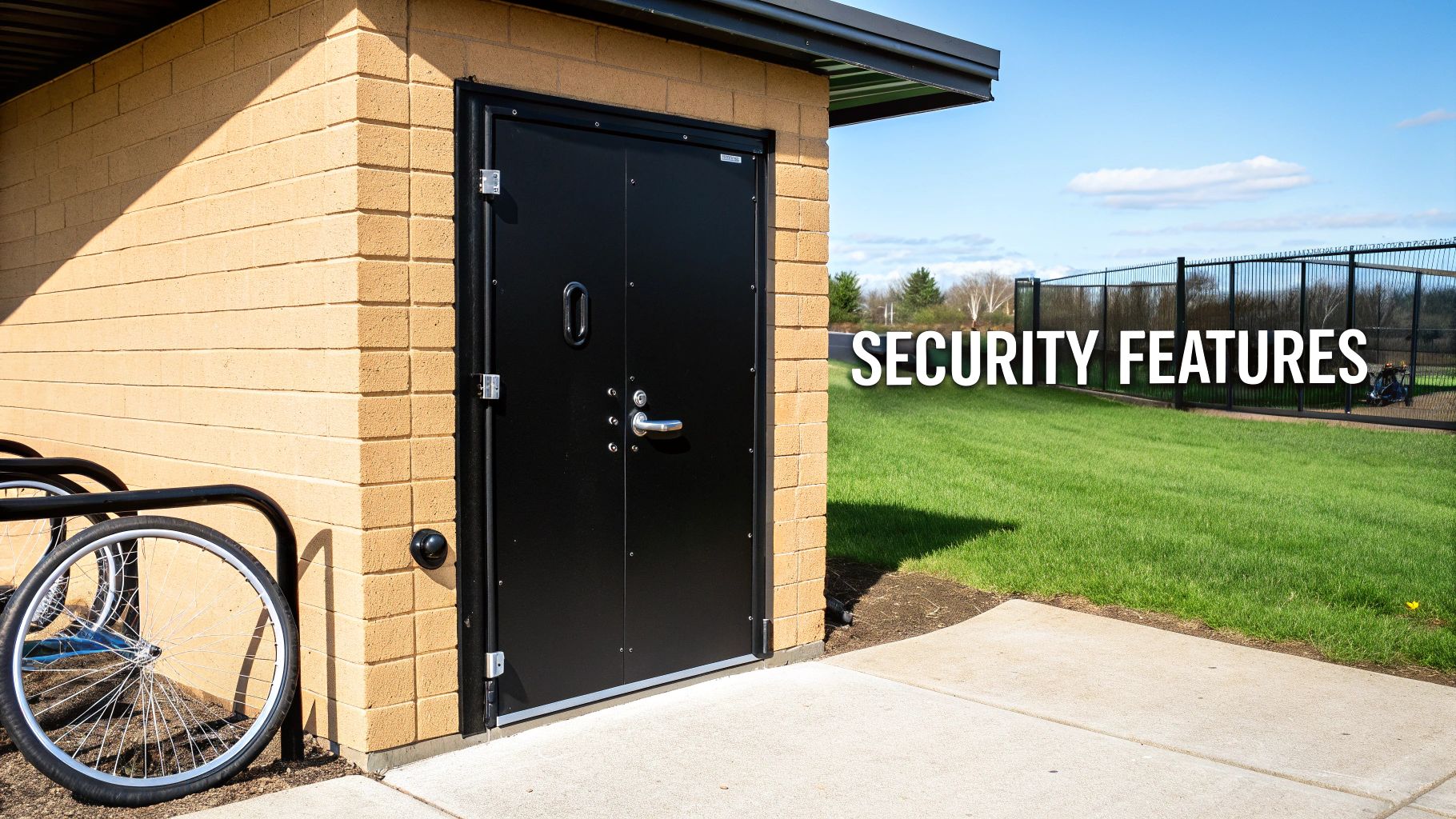
As a family business that’s been focused on security since 1972, we know from experience that the small details make all the difference. Let's dive into the non-negotiable features that turn a simple storage unit into a long-term investment in your peace of mind.
It All Starts with the Right Materials
The material of your shelter is its first line of defence. You’ll see plenty of options out there, but they offer vastly different levels of protection.
Heavy-Gauge British Steel is, without a doubt, the top choice for keeping vehicles secure. It’s incredibly tough to cut, bend, or drill, presenting a serious headache for any would-be thief. Always look for shelters made from thick, galvanised steel, which gives you a built-in layer of rust protection from the get-go.
Wood might look nice in the garden, but it offers minimal security. A determined thief can get through wooden panels with basic tools in just a few seconds. It also demands regular upkeep to stop it from rotting and falling apart in our climate.
Plastic shelters are lightweight and won't rust, but they provide the lowest level of security. They can become brittle, especially in the cold, and can often be forced open with little more than a good shove. They’re fine for keeping the rain off, but not for stopping a theft.
Locking Mechanisms: The Heart of Protection
A strong box is pretty useless without a strong lock. The type of locking mechanism is a critical feature that directly impacts your shelter's ability to put off criminals.
A simple hasp and staple for a padlock is a basic deterrent, but it’s often the weakest link. For real security, you need to look for shelters with integrated, multi-point locking systems. These systems bolt the door shut at several points within the frame, making it much, much harder to pry open. This is standard on high-security doors and a must-have for protecting valuable bikes.
We believe in layered security. Our shelters are designed with robust, drill-and-pick-resistant locks as standard. This focus on the locking mechanism is central to our commitment to British-made quality and comes with a 2-year warranty for your confidence.
Weatherproofing for the UK Climate
After a thief, your bike's biggest enemy is the British weather. A truly secure shelter has to be a truly weatherproof one, protecting your investment from rust, corrosion, and damp.
This is where the finish of the steel becomes vital. Here’s what to look for:
- Galvanisation: This is a process where the steel is coated in a layer of zinc. It creates a protective barrier that stops rust from forming, even if the outer surface gets scratched.
- Powder Coating: This is a durable, baked-on paint finish that adds a tough external layer. It protects against scrapes, knocks, and UV damage, while also offering a clean, professional look in a range of colours.
A shelter that is both galvanised and powder-coated offers the ultimate defence against the elements, ensuring it will stand strong for years to come.
Essential Design Details: Ventilation and Anchoring
Two often-overlooked features are crucial for both security and the long life of your bike: ventilation and ground anchoring. Proper ventilation stops condensation from building up inside, which can cause rust and damage your bike's components over time. Discreet vents let air circulate without creating a weak spot.
Just as important is how the shelter is fixed to the ground. A unit that isn't securely anchored could potentially be lifted or tipped over by determined thieves. A quality home bicycle shelter must have integrated fixing points that allow it to be bolted directly into a solid concrete base. This is the final, crucial step in creating an immovable security asset. The principles of a secure bike shelter aren't so different from other security structures; you can learn a lot from the key features of high-quality security fencing.
The need for this level of security is especially high during the warmer months. Research shows that bicycle theft in the UK can jump by over 130% between May and September as more people get out on their bikes. For even more protection inside your shelter, consider installing one of our internal bike racks to provide an additional locking point.
Planning Your Shelter's Location and Size
Two simple questions can stop a great idea in its tracks: 'Will it actually fit?' and 'Where on earth do I put it?'. When it comes to picking a home bicycle shelter, getting these two things right is the difference between a perfect solution and a daily frustration. Let's get these practical problems sorted right now.
As a family business that’s been helping UK homeowners with security since 1972, we’ve seen every type of garden, driveway, and awkward side-return imaginable. With a bit of careful planning, you can find the ideal spot for your shelter, making sure it’s both convenient and secure.
Getting the Measure of Your Space and Bikes
Before you fall in love with a particular design, it’s time to grab a trusty tape measure and spend a few minutes on some practical thinking. Accurately measuring both your available space and your bikes will ensure you choose a shelter that fits perfectly from day one.
First up, let's think about the bikes themselves. Modern bicycles, especially e-bikes and chunky cargo bikes, are often longer and wider than you might realise.
- Measure Everything: Don't just guess. Measure the total length of your longest bike from tyre to tyre, and the width at its widest point (usually the handlebars).
- Allow for Wiggle Room: A shelter's internal dimensions should be at least 10-15cm larger than your bike's measurements. This bit of extra space makes it so much easier to get bikes in and out without scratching frames or catching pedals.
- Think About Height: If you're looking at a vertical storage unit, measure your bike's height from the floor to the top of the handlebars or saddle. Make sure there’s enough clearance.
- The Door Swing: This is a classic oversight! When measuring your ground space, you absolutely must account for the area needed for the door to swing fully open. You don't want to find your access blocked by a fence or a wall.
By taking these quick measurements, you’ll have a clear picture of the minimum internal size you need, which is a fantastic starting point for browsing different models.
Choosing the Best Location
Once you know the footprint your shelter requires, the next job is deciding where it should live. The best location is a balance between convenience for you and major inconvenience for potential thieves. The two most common options are the front or back garden.
A front garden location offers fantastic convenience. You can roll your bike straight out and be on your way, which is a huge plus for daily commuters. However, it also means the shelter is more visible from the street. If you go for this option, it is absolutely essential that the shelter is a high-security, robustly built model made from British steel. Its very presence should be a powerful deterrent.
Placing the shelter in a back garden keeps it out of sight, reducing its visibility to opportunistic thieves. This is generally the more secure option, provided your back garden itself is secure with locked gates. The only real downside is the potential hassle of wheeling your bike through the house or a narrow side passage every day. Our range includes options for all sorts of spaces, including compact units for tighter spots like our popular 2-person shelters.
A key consideration that often gets missed is the view from your home. Ideally, place your shelter where you can see it from a window. This natural surveillance is a simple but really effective layer of security.
The Importance of a Solid Foundation
Finally, and most crucially, your home bicycle shelter needs a solid, level base to sit on. Its security is only as good as its foundation. An uneven or soft base, like grass or soil, can cause the shelter's frame to warp over time, making doors difficult to close and locks a nightmare to operate.
More importantly, a solid base is vital for securely anchoring the unit.
- Concrete Slab or Paving: These are the gold standard. They provide a stable, level foundation and allow the shelter to be securely bolted down with anchor bolts, making it impossible for thieves to lift or tip it over.
- Preparation is Key: If you don’t have a suitable base already, preparing one is a worthwhile investment in your bike's security.
- Check Below Ground: Before you start any groundwork, always check for underground services like water pipes, gas lines, or electrical cables. A quick check now can prevent a world of trouble later on.
Getting these three elements—size, location, and foundation—right from the start will make sure your new shelter is a secure, convenient, and long-lasting asset for your home.
A Practical Guide to Installation and Maintenance
A high-quality home bicycle shelter is a fantastic investment, but its real-world security all comes down to how it's put together. Just like a house needs solid foundations, your shelter is only as strong as its installation. Let's walk through your options to make sure your bike gets the protection it deserves.
As a family-run business that has specialised in security since 1972, we’ve seen first-hand that a job done right from the start saves a lot of headaches later on. Whether you’re a keen DIYer or would rather leave it to the experts, we’ll cover what you need to know.
DIY Installation Considerations
For those who are confident with a toolkit, putting the shelter together yourself can be a really rewarding project. The key is preparation. Before you even think about unpacking the box, make sure you have a solid, level base ready to go—ideally concrete or paving slabs. This is absolutely critical for both stability and security.
Most importantly, a DIY installation requires securely anchoring the unit to this base. It’s this step that transforms your shelter from a simple box into an immovable piece of vehicle security.
When assembling your British-made shelter, make sure you have:
- The Right Tools: A good drill, spanners, and a spirit level are non-negotiable.
- A Helping Hand: These are solid steel units, so having another person to help makes the process much safer and a whole lot easier.
- Clear Instructions: Always follow the assembly guide step-by-step. Don't skip ahead! This ensures every component is fitted exactly as it should be.
The Professional Installation Advantage
For guaranteed peace of mind, you just can't beat our professional installation service. Our experienced, in-house teams handle everything, making sure your shelter is assembled to the highest possible standard. Choosing this option means you can be confident your investment is perfectly secure from day one.
Our installation service isn’t just about convenience; it's about guaranteeing the security and integrity of your shelter. We ensure it's perfectly level, all locking mechanisms function flawlessly, and it's securely anchored to withstand both determined thieves and the worst of the British weather.
Our teams take care of all the heavy lifting and precise assembly, a service backed by our family's five decades of expertise. This professional touch ensures your 2-year warranty is fully supported by a flawless setup.
Simple Maintenance for Long-Lasting Security
Once your shelter is up, a few simple checks will keep it in prime condition for years to come. Protecting your investment doesn't take much effort, just a little regular attention.
Here are a few actionable tips to keep your shelter performing perfectly:
- Lubricate the Locks: A quick spray of WD-40 or a similar lubricant into the lock mechanism every few months will stop it from seizing, especially during cold, wet weather.
- Check the Fixings: Once a year, take a moment to check that all the bolts and ground anchors are still tight. Vibrations and temperature changes can occasionally cause things to loosen over time.
- Keep it Clean: Regularly sweep away any leaves or debris that might gather around the base or in the door tracks. This simple job prevents moisture from getting trapped against the steel and ensures everything opens and closes smoothly.
By following these simple steps, you'll ensure your British-made home bicycle shelter continues to provide formidable driveway protection, season after season.
Making the Right Choice for Your Home and Your Bike
Right, let's pull all of this together. By now, you should have a solid grasp of how to size up your space, the different kinds of shelters on the market, and the absolute must-have features for keeping your bike safe. Choosing the right home bicycle shelter isn't just about finding a place to park your bike; it's about getting back that simple joy of cycling without the constant, nagging worry at the back of your mind.
As a family-owned business that's been obsessed with security since 1972, we pour everything we know into our British-made products. Now, it's over to you.
Your Personal Security Checklist
Before you make that final decision, just run through these key questions one last time. Think of it as a final check to make sure the shelter you've chosen is a perfect match for your needs, giving you real confidence in your investment.
- Have I measured my biggest bike? Don't forget the handlebars, and make sure to leave at least 10-15cm of wiggle room so you're not fighting to get it in and out.
- Is my chosen spot on a solid, level base? A concrete or paved foundation is non-negotiable for a secure anchor and to stop it from wobbling over time.
- Does the shelter have integrated, multi-point locking? This is your best defence against someone trying to force their way in.
- Is it made from heavy-gauge, galvanised, and powder-coated steel? This trio is the ultimate shield against both opportunistic thieves and the classic British weather.
This focus on secure, easy-to-access storage isn't just a homeowner's concern; it's a growing priority across the entire country. Take London, for instance. Lambeth Council has already installed over 600 on-street cycle hangars, creating thousands of secure spots for residents. It just goes to show how vital top-quality cycle storage has become in modern urban life. You can read more about how Lambeth Council is expanding its residential cycle parking provisions to get more people on their bikes.
A quality home bicycle shelter brings that exact same principle of secure, convenient storage right to your own doorstep.
We'd invite you to explore our full range of British-made home bicycle shelters or have a chat with our expert team. Let's find the perfect solution to protect your bike, so you can get back to focusing on the ride ahead.
Your Questions Answered
We’ve covered a lot of ground, but you probably still have a few things you're wondering about. As a family business that’s been focused on British-made security since 1972, we’ve heard just about every question there is. Here are some quick, straight-to-the-point answers to the queries we get most often from homeowners across the UK.
Do I Need Planning Permission?
This is one of the first things people ask, and it's a sensible question. For the most part, a home bicycle shelter is considered 'permitted development' for outbuildings here in the UK. In simple terms, this means you usually don't need to apply for planning permission.
However, there are always exceptions to the rule. We always recommend a quick chat with your local council just to be sure, especially if your property is in a conservation area, a National Park, or is a listed building, as the rules can be different.
Are Metal Shelters Noisy in the Rain?
It’s a fair point – nobody wants a constant drumming sound right outside their window every time it rains. While you’ll obviously hear the rain on a metal roof, it’s nowhere near as loud as you might imagine.
Our shelters are built from heavy-gauge British steel, and a solid, professional installation really helps to deaden the sound. The noise is more like what you’d hear inside a car or a conservatory during a downpour – a gentle, ambient sound rather than a disruptive racket.
How Should I Secure an E-Bike Inside?
An e-bike is a serious investment, so adding another layer of security is always the smartest way to go. Even with a locked shelter, an extra step gives you that ultimate peace of mind.
We strongly advise using the shelter’s own high-security locking system as your first line of defence. For the second step, secure your e-bike’s frame to a ground anchor fitted inside the shelter itself. You'll want to use a separate, top-quality lock for this – ideally, one that’s Sold Secure Gold rated, which is the standard that UK insurance companies look for.
This two-step method presents a massive headache for any potential thief. They’d have to get through the shelter’s heavy-duty lock first, only to be faced with another top-rated lock inside. It makes your bike a very, very difficult target.
Galvanised vs Powder-Coated Steel: What’s the Difference?
Think of it like giving the shelter two different types of armour, each with its own job.
- Galvanising is a process where the steel gets a coating of zinc. This isn't just a surface layer; it creates a chemical bond that protects the steel from the inside out. It's fantastic at stopping rust and corrosion, even if the surface gets a scratch.
- Powder Coating is the tough, coloured paint finish that's baked onto the metal. This provides brilliant protection against knocks, scrapes, and the general wear and tear from our lovely British weather, while also giving the shelter its final colour.
A shelter that is both galvanised and powder-coated offers the absolute best of both worlds. It’s the gold standard for a long-lasting, weatherproof, and secure investment for your home.
At Bison Products, we're committed to providing British-made security solutions that give you complete peace of mind. Our range of home bicycle shelters is designed to offer maximum protection, with professional installation available nationwide.

